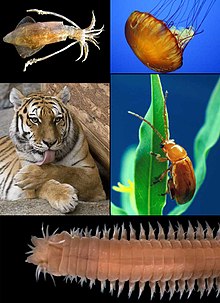Planulozoa
| Planulozoa | |
|---|---|

| |
| Diversity of planulozoans | |
| Scientific classification | |
| Kingdom: | |
| Subkingdom: | |
| (unranked): | |
| (unranked): | Planulozoa Wallberg et al., 2004
|
| Phyla | |
|
Bilateria/Triploblasts (unranked)
| |
Planulozoa is a proposed basal ParaHoxozoa clade, conventionally as sister of the Placozoa. It contains the Cnidaria (sea anemones and jellyfish) and the Bilateria (all the more complex animals including flatworms, insects and vertebrates). The Placozoa may be a sister of Cnidaria[1][2][3][4] or more conventionally of Planulozoa.[5] The clade excludes basal animals such as the Ctenophora (comb jellies),[6][7][8] and Porifera (sponges).[9][10][11]
The phylogenetic tree indicates approximately how many millions of years ago (mya) the lineages split.[12][13][14]
| Apoikozoa |
| ||||||||||||||||||||||||||||||||||||||||||||||||
| 950 mya |
References
- ^ Aleshin VV, Petrov NB (2002) Molecular evidence of regression in evolution of metazoa. Zh Obshch Biol 63(3):195-208
- ^ Laumer, Christopher E.; Gruber-Vodicka, Harald; Hadfield, Michael G.; Pearse, Vicki B.; Riesgo, Ana; Marioni, John C.; Giribet, Gonzalo (2017-10-11). "Placozoans are eumetazoans related to Cnidaria". bioRxiv 200972.
{{cite bioRxiv}}: Check|biorxiv=value (help); Cite has empty unknown parameter:|1=(help) - ^ Schuchert, Peter (1993-03-01). "Trichoplax adhaerens (Phylum Placozoa) has Cells that React with Antibodies Against the Neuropeptide RFamide". Acta Zoologica. 74 (2): 115–117. doi:10.1111/j.1463-6395.1993.tb01227.x.
- ^ Syed, Tareq; Schierwater, Bernd (2002-06-01). "The evolution of the placozoa: A new morphological model". Senckenbergiana lethaea. 82 (1): 315–324. doi:10.1007/bf03043791. ISSN 0037-2110.
- ^ Eitel, Michael; Francis, Warren; Osigus, Hans-Jürgen; Krebs, Stefan; Vargas, Sergio; Blum, Helmut; Williams, Gray Argust; Schierwater, Bernd; Wörheide, Gert (2017-10-13). "A taxogenomics approach uncovers a new genus in the phylum Placozoa". bioRxiv: 202119. doi:10.1101/202119.
- ^ Andreas Hejnol; Mark Q. Martindale (2008). "Acoel development supports a simple planula-like urbilaterian". Philosophical Transactions of the Royal Society B. 363 (1496): 1493–1501. doi:10.1098/rstb.2007.2239. PMC 2614228. PMID 18192185.
{{cite journal}}: Unknown parameter|lastauthoramp=ignored (|name-list-style=suggested) (help) - ^ Jaume Baguñà; Pere Martinez; Jordi Paps; Marta Riutort (2008). "Back in time: a new systematic proposal for the Bilateria". Philosophical Transactions of the Royal Society B. 363 (1496): 1481–1491. doi:10.1098/rstb.2007.2238. PMC 2615819. PMID 18192186.
- ^ Andreas Wallberg; Mikael Thollesson; James S. Farris; Ulf Jondelius (2004). "The phylogenetic position of the comb jellies (Ctenophora) and the importance of taxonomic sampling". Cladistics. 20 (6): 558–578. doi:10.1111/j.1096-0031.2004.00041.x.
- ^ Whelan, Nathan V.; Kocot, Kevin M.; Moroz, Tatiana P.; Mukherjee, Krishanu; Williams, Peter; Paulay, Gustav; Moroz, Leonid L.; Halanych, Kenneth M. (2017-10-09). "Ctenophore relationships and their placement as the sister group to all other animals". Nature Ecology & Evolution. doi:10.1038/s41559-017-0331-3. ISSN 2397-334X.
- ^ C. Borchiellini; M. Manuel; E. Alivon; N. Boury-Esnault; J. Vacelet; Y. Le Parco (2001). "Sponge paraphyly and the origin of Metazoa". Journal of Evolutionary Biology. 14 (1): 171–179. doi:10.1046/j.1420-9101.2001.00244.x.
- ^ Pisani, Davide; Pett, Walker; Dohrmann, Martin; Feuda, Roberto; Rota-Stabelli, Omar; Philippe, Hervé; Lartillot, Nicolas; Wörheide, Gert (2015-12-01). "Genomic data do not support comb jellies as the sister group to all other animals". Proceedings of the National Academy of Sciences. 112 (50): 15402–15407. Bibcode:2015PNAS..11215402P. doi:10.1073/pnas.1518127112. PMC 4687580. PMID 26621703.
- ^ Peterson, Kevin J.; Cotton, James A.; Gehling, James G.; Pisani, Davide (27 April 2008). "The Ediacaran emergence of bilaterians: congruence between the genetic and the geological fossil records". Philosophical Transactions of the Royal Society of London B: Biological Sciences. 363 (1496): 1435–1443. doi:10.1098/rstb.2007.2233. PMC 2614224. PMID 18192191.
- ^ Parfrey, Laura Wegener; Lahr, Daniel J. G.; Knoll, Andrew H.; Katz, Laura A. (16 August 2011). "Estimating the timing of early eukaryotic diversification with multigene molecular clocks". Proceedings of the National Academy of Sciences. 108 (33): 13624–13629. Bibcode:2011PNAS..10813624P. doi:10.1073/pnas.1110633108. PMC 3158185. PMID 21810989.
- ^ "Raising the Standard in Fossil Calibration". Fossil Calibration Database. Retrieved 3 March 2018.



